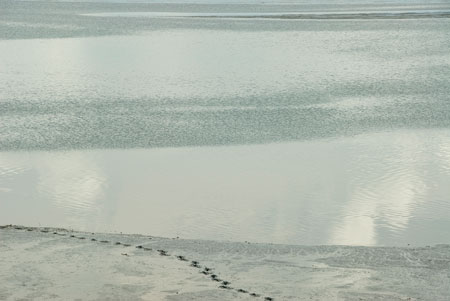Posted by Sunil Gangadharan on July 19th, 2007
Reading Karl’s latest post about Ultra Minimal Non-Conceptual art got me thinking a bit about where we are headed as far as art movements go. Here is my view.
Please bear in mind that this post was purely based on my ideas and observations and at most the product of an effort to understand the art world better. Hopefully I have managed to convey some sense, but if not, my sincere apologies.
Since a picture is worth a 1000…, I created a little graph to clarify the thinking a bit further and here goes… more… »
Filed in Uncategorized
- Comments closed
Posted by Doug Plummer on July 18th, 2007

I’ve not posted here for the last month, as I’ve been deep into computer management issues. Creativity has been at a low ebb, as has been anything cogent to say about the process. But I’m on the road now, which always gets me creatively engaged with my surroundings.
We’re visiting friends on Salt Spring Island, which is between the BC mainland and Vancouver Island. The hills and sea coves are spectacular, of course. Walking with friends at Ruckle Provincial Park, I explored the woods and beach with my camera as they conversed. I felt like the off leash dog lingering behind to check out the compelling scents along the trail.
Washed up on the rocky coast, with all the other woodsy flotsam, was a huge stump with its ring of roots, whitened by many seasons in the sun. I’m a sucker for these sorts of things. No matter that this is a well worn rut in photographic explorations–the reason photographers are attracted to eroded rocks and convoluted trees is that they’re interesting natural forms to stare at. I am not above joining the fray, so long as I get to do it in relative solitude.
The more I started poking around this stump, the more I appreciated how this was one of the more complex shapes in a natural object that I had encountered in awhile. By taking pictures of it, sitting in it and looking, and looking, and extracting more shapely photographs, and looking some more, I got to “know” this thing. I crawled in close, and I backed off and saw how it sat in the larger landscape. I began a relationship.
We had about 30 minutes together, this stump and I. Most people, and me in another mood, would have walked by, glanced at the stump, thought, hey, that’s cool looking, and gone on their way. The camera was an excuse to linger and really feel what this spot was like for the duration.




Filed in from life,landscape,photography
- Comments closed
Posted by Steve Durbin on July 16th, 2007
Sunil’s recent post was most provocative. It’s not often that someone seeks comment about his or her self portrait. Turns out that Sunil may have opened a rich vein.
I appreciate the opportunity to witness a participant, not just through the trajectories of post and comment, but as the individual presents his or herself in an image.
In that spirit I would like to throw my mug in the ring.
more… »
Filed in from photos,portrait
- Comments closed
Posted by Karl Zipser on July 16th, 2007

Painting
From Life vs.
From Photos
On Saturday I posted about Ultra Minimal Non-Conceptualism, which I claim is to be the Big New Thing. Yesterday a venture-capitalist art collector (let’s call him S.) contacted me. S. wanted to buy the first exemplar of an Ultra Minimal Non-Conceptual artwork.
We started our discussion of the commission with the most important question: what would the first Ultra Minimal Non-Conceptual piece cost? more… »
Filed in Uncategorized
- Comments closed
Posted by Karl Zipser on July 14th, 2007

Painting
From Life vs.
From Photos
Art without a “conceptual edge” can nowadays seem “out of it”, un-hip, old-fashioned. Art that is little more than the ultra-minimalist depiction of a concept can sell for millions. Why is the conceptual trendy, and how to cash in? more… »
Filed in Uncategorized
- Comments closed
Posted by Birgit Zipser on July 13th, 2007

I am visiting the Wattenmeer (mud flats) where I grew up.
more… »
Filed in photography
- Comments closed
Posted by Sunil Gangadharan on July 12th, 2007
Van Gogh did self portraits because he had no money to pay models. Rembrandt used it as a vehicle to improve his artistic skills as well as to study the minute emotional states inflicted by muscular inflections on his face. Women artists of the 1800’s did it because they were not allowed access to live models and social restrictions made it difficult for them to paint publicly. Others like Frida Kahlo examined the different psychological underpinnings behind the ‘self’ using the self portrait as a tool, a vehicle. Gentileschi used the portrait as a mask that tended to hide the viewer from the self that the artist wanted to conceal. There are so many different reasons for creating a self portrait.
It is also instructive (and fun) to read the opinions of Art and Perception contributors to this art form. more… »
Filed in Uncategorized
- Comments closed






